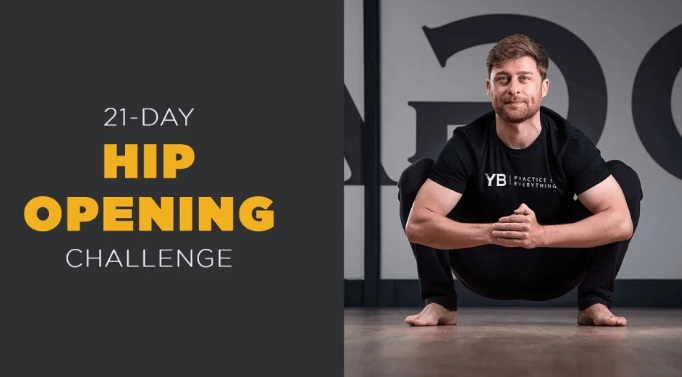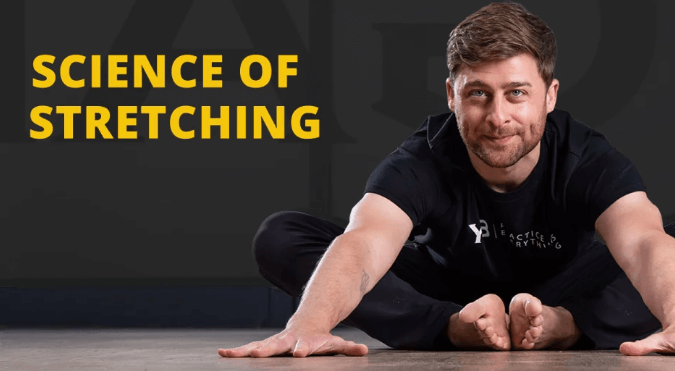Yogabody – 21-Day Hip Opening Challenge

If you suffer from tight hips that affect your posture, your ability to squat, and your yoga
practice, there’s a very good chance I can help you. I’m leading an online 21-Day Hip
Opening Challenge to blast through years of stress, tension, and tightness.
Why Does Hip Flexibility Matter?
The Modern Tight Hip Problem
In 2003, I moved to Thailand and began my yoga teaching journey. The very first thing that every Western yoga teacher notice in Southeast Asia is that tight hips are very rare. Why? Natural movement patterns are still very common in the region. Squatting is a normal part of daily life for most people; there are squat toilets, temples have no chairs, etc.
But what about you? When was the last time you dropped down into a full squat to wash your laundry, peel a carrot, or use the bathroom? The answer is probably never, and that is a huge part of the modern tight hip problem. The average person living in a Western country rarely flexes their knees past 90-degrees or squats at all.
Think about it. You wake up, roll out of bed, and sit down on a knee-high toilet. You make breakfast and sit on a chair or a stool that is at bum-height (or higher). You get into a car (again in a seat), arrive at work and promptly sit down in an office chair. The muscles and tissues that affect flexion and extension, adduction and abduction, internal and external rotation are barely used at all!
Interestingly, this is not true for children.
Most kids sit on the floor, squat to play with toys, and move through a full range of hip motion throughout the day. By age 10, most kids are starting to move more like adults (meaning less) and they begin to lose flexibility. Without training, by our teenage years, most of us are just as stiff as an adult. That’s the bad news. The good news is that you can change this. It doesn’t happen overnight, but with consistent practice, you can make massive gains in flexibility.
The Danger of Tight Hips
Many people assume that tight hips are simply inconvenient. You can’t sit comfortably on the floor, many yoga poses are out of reach, and you get fidgety and uncomfortable in the car and on planes. But it’s much worse than that.
When your hips are tight, you automatically adjust your movement patterns to make up for it. When you squat, your feet turn out and your heels pop up. When you sit cross-legged, your back hunches up into a ball. When you run, your hips don’t fully extend, so your running gait turns into a clumsy waddle, especially when you become fatigued.
All these movement workarounds contribute or even cause chronic back and knee pain, among other problems. When you’re walking, sitting, and running around with poor posture, you’re simply more prone to injury.

Hip Flexibility Involves 20+ Muscles
Most people don’t realize that hip joint mobility is affected directly or indirectly by more than 20 different muscles, including various hip flexors, extensors, rotators, abductors, and adductors. And this doesn’t even take into account the fascia!
True hip mobility is complex and multifactorial, so a mobility program has to include long-hold poses to access all those muscles and you need to practice a variety of poses to hit the various areas in different ways.
Are there go-to poses we come back to again and again? Of course, but there are also strange (and uncomfortable) variations and modifications that take things to another level.
My Embarrassingly Tight Hip Story…
Six months before I began my yoga journey, I was invited to a raw food lecture at a yoga studio in Manhattan. There were no chairs, obviously, so I spent 90-minutes sitting (or attempting to sit) cross-legged on the floor. My knees were at chest height, my back was hunched up, and I was literally sweating with discomfort.
At the time, I’d never thought twice about flexibility—and especially not hip flexibility—but as I suffered through the lecture, I noticed a bunch of people much older than me were able to cross their legs with their knees on the floor, and some were even resting in Half Lotus or Full Lotus without any effort. They weren’t faking it either, they were truly relaxed sitting on the floor, while I was in dire misery.
So, what happened next?
At first, nothing. I just felt bad about myself, concerned that I’d let myself go and that my daily gym workouts were somehow misguided (which they were!). Six months later, I started practicing yoga at a local studio, and the classes were amazing—but my hips were still two blocks of ice. Nothing new there.
The big shift in flexibility happened when I learned the principles of theScience of Stretching™. I learned that muscle tissue stretches best under passive tension and that the nervous system plays a huge role in the stretch reflex. If that all sounds like gibberish to you, I’ll make it very simple: I learned that for flexibility training, long-hold, passive poses, with specific breathing patterns were the only way to go.
And it worked. Flexibility gains are not as quick to achieve as strength gains, but they last so much longer. Once you open your hips, they’ll stay open unless you start doing repetitive stress exercises or stop stretching all together.
That’s why I love the Science of Stretching™. It’s like a flexibility savings account. Every time you deposit five minutes in a long-hold stretch, it adds to your overall mobility and flexibility. I went from not being able to sit on the floor with my legs crossed to being able to sit in Full Lotus Pose for an hour straight, practice deep lunges with ease, and eventually put my foot behind my head (this is not really useful or even recommended, but just something that happened).
My 21-Day Challenge to You
My challenge to you is very simple. Join me for 15 minutes a day, every day, for 21 days, and let’s unlock your tight hips! We’ll stretch, breathe, chat about yoga and nutrition, and practice together. I’ll show you my own favorite Science of Stretching™ hip opening stretches, and you can practice right along with me.
Students contact me every week wanting to join my classes, but these days, most of my teaching is restricted to intensive training courses—sometimes on the other side of the world—that most people are unable to attend. This short course is my attempt to share my practices and my best stretching knowledge with you, as if we were hanging out in my studio.
What is Science of Stretching™?
Science of Stretching™ is a systematic approach to flexibility training that I developed after studying and comparing notes with some of the leading yoga teachers, physiotherapists, and movement specialists in the world. The truth is, experts argue about the best method to train flexibility, but what I’ve found is that for people who need flexibility—yoga students, gymnasts, and dancers—the consensus is pretty much the same.
For flexibility gains, you need to supplement whatever you’re doing with long-hold passive postures that target specific areas. When I teach, I also pair it with a down-regulating breathing pattern to assist in shutting off the stretch reflex and encouraging relaxation and release.
I introduced Science of Stretching™ in 2007, and it has since been practiced by more than 80,000 students worldwide. At my yoga studios in Barcelona, we teach regular, guided classes, and they are among the most popular for one simple reason: they work. You get results.
Science of Stretching™ is not a complete practice or exercise routine. It’s specifically focused on one thing—flexibility—and it’s meant to complement whatever else you’re doing for exercise.
Join the 21-Day Hip Opening Challenge
Online Video Course

BENEFITS
- Huge flexibility gains
- Deep relaxation
- Tension release
- Personalized teaching
- Direct access to Lucas Rockwood
HOW IT WORKS
- 15 minutes per day x21 days
- Daily video classes
- Answers to all your questions
- Amazing, supportive community
- Guaranteed results
FORMAT
- Daily video session & Q&A
- Access to all videos lifetime
REQUIREMENTS
- Smart phone or tablet
- 15 Minutes Per Day
- Yoga mat




Reviews
There are no reviews yet.